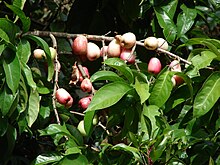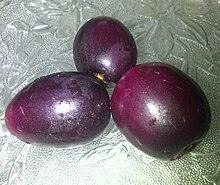Syzygium (/sɪˈzɪdʒiːəm/)[3] is a genus of flowering plants that belongs to the myrtle family, Myrtaceae. The genus comprises about 1200 species,[4][5][6] and has a native range that extends from Africa and Madagascar through southern Asia east through the Pacific.[7] Its highest levels of diversity occur from Malaysia to northeastern Australia, where many species are very poorly known and many more have not been described taxonomically. One indication of this diversity is in leaf size, ranging from as little as a half inch (one cm) to as great as 4 ft 11 inches (1.5 meters) by sixteen inches (38 centimeters) in Syzygium acre of New Caledonia.[8]
| Syzygium | |
|---|---|
 | |
| Syzygium malaccense | |
| Scientific classification | |
| Kingdom: | Plantae |
| Clade: | Tracheophytes |
| Clade: | Angiosperms |
| Clade: | Eudicots |
| Clade: | Rosids |
| Order: | Myrtales |
| Family: | Myrtaceae |
| Subfamily: | Myrtoideae |
| Tribe: | Syzygieae |
| Genus: | Syzygium P. Browne ex Gaertn.[1] |
| Species | |
About 1100; see List of Syzygium species | |
| Synonyms[2] | |
List
| |


Most species are evergreen trees and shrubs. Several species are grown as ornamental plants for their attractive glossy foliage, and a few produce edible fruits called roseapples that are eaten fresh or used in jams and jellies. The most economically important species, however, is the clove Syzygium aromaticum, of which the unopened flower buds are an important spice. Some of the edible species of Syzygium are planted throughout the tropics worldwide, and several have become invasive species in some island ecosystems. Fifty-two species are found in Australia and are generally known as lillipillies, brush cherries or satinash.[9]
At times Syzygium was confused taxonomically with the genus Eugenia (c. 1000 species), but the latter genus has its highest specific diversity in the neotropics. Many species formerly classed as Eugenia are now included in the genus Syzygium, although the former name may persist in horticulture.[9] The Syzygium Working Group, an international group of researchers, formed in April 2016 with the aim to produce a monograph of Syzygium.[6]
The term comes from the Greek word syzygia, meaning "joining together or conjunction".[10][11]
Species


Selected species include:[4]
- Syzygium acre (Pancher ex Guillaumin) J.W.Dawson
- Syzygium alliiligneum – onionwood (Queensland)
- Syzygium alternifolium (Wight) Walp.
- Syzygium ampliflorum (Koord. & Valeton) Amshoff
- Syzygium amplifolium
- Syzygium andamanicum
- Syzygium anisatum
- Syzygium angophoroides
- Syzygium anisosepalum
- Syzygium antisepticum – shore eugenia
- Syzygium apodophyllum (F.Muell.) B.Hyland - endemic to Queensland, Australia
- Syzygium aqueum – water apple, bell fruit, water cherry, watery rose apple
- Syzygium aromaticum – clove
- Syzygium australe – brush cherry (Australia)
- Syzygium beddomei
- Syzygium bourdillonii
- Syzygium canicortex – yellow satinash (Queensland)
- Syzygium caryophyllatum (type species)
- Syzygium chavaran
- Syzygium claviflorum (Roxb.) Wall. ex Steud. – Australia, New Guinea, Southeast Asia, China, India
- Syzygium conglomeratum
- Syzygium contractum
- Syzygium cordatum – Hute, waterbessie, undoni, water berry, umSwi
- Syzygium cordifolium
- Syzygium cormiflorum – Bumpy satinash
- Syzygium corynanthum – Sour cherry
- Syzygium courtallense
- Syzygium crebrinerve – Purple cherry, black water gum
- Syzygium cumini (L.) Skeels – Jambul, Jambolan, Black plum, Duhat plum, Jambolan plum
- Syzygium curranii - Lipote
- Syzygium densiflorum
- Syzygium diffusum
- Syzygium discophorum
- Syzygium duthieanum
- Syzygium dyerianum
- Syzygium elegans
- Syzygium erythrocalyx – Johnstone River satinash, Red Bud satinash
- Syzygium eucalyptoides
- Syzygium fibrosum – Fibrous satinash
- Syzygium fijiense
- Syzygium floribundum F.Muell.
- Syzygium flosculiferum
- Syzygium forte – White Apple
- Syzygium formosanum – Native to Taiwan
- Syzygium francisii – Giant water gum, rose satinash
- Syzygium fullagarii (Lord Howe Island)
- Syzygium glaucum
- Syzygium goodenovii (King) Masam.
- Syzygium graeme-andersoniae
- Syzygium grande – Sea apple
- Syzygium guehoi
- Syzygium guineense – Waterberry
- Syzygium gustavioides – Grey satinash
- Syzygium hemisphericum (Wight) Alston
- Syzygium hodgkinsoniae – Red lilly pilly, smooth-barked rose apple (Australia)
- Syzygium ingens (F.Muell. ex C.Moore) Craven & Biffin
- Syzygium jambos (L.) Alston – Roseapple, Malabar plum, plum rose, rose apple, water apple
- Syzygium jasminifolium
- Syzygium kemamanense
- Syzygium kiahii
- Syzygium koordersianum
- Syzygium kuranda – Kuranda satinash
- Syzygium leucoxylon
- Syzygium luehmannii – Riberry, cherry satinash
- Syzygium maingayi
- Syzygium maire (A.Cunn.) Sykes & Garn.-Jones
- Syzygium makul Gaertn.
- Syzygium malaccense (L.) Merr. & L.M.Perry – Malay Apple, Malacca apple, Malay rose apple, mountain apple, Otaheite cashew, rose apple, water apple
- Syzygium manii (King) N.P.Balakr.
- Syzygium micranthum
- Syzygium microphyllum (Syzygium gambleanum is an illegitimate synonym)
- Syzygium minus
- Syzygium mishmiense Chatterjee
- Syzygium monimioides
- Syzygium moorei – Coolamon, durobby
- Syzygium myhendrae
- Syzygium myrtifolium – red lip
- Syzygium neesianum
- Syzygium nemestrinum
- Syzygium nervosum
- Syzygium occidentale
- Syzygium oleosum – Blue lilly pilly
- Syzygium oliganthum
- Syzygium oreophilum
- Syzygium palghatense
- Syzygium paniculatum – Magenta lillypilly, magenta cherry (Australia)
- Syzygium parameswaranii
- Syzygium patentinerve (endemic to Savai'i & Upolu islands in Samoa)[12]
- Syzygium papyraceum – Paperbark satinash (Australia)
- Syzygium pauper
- Syzygium pendens
- Syzygium perakense, now accepted as synonym for Syzygium formosum
- Syzygium pergamentaceum
- Syzygium phaeophyllum
- Syzygium politum
- Syzygium polyanthum (Wight) Walp. – Indian bay leaf, Indonesian bay leaf, Salam leaf, daun salam, Indonesian laurel
- Syzygium polycephaloides - Lipote
- Syzygium pondoense
- Syzygium praineanum
- Syzygium pseudofastigiatum (Australia)
- Syzygium purpureum
- Syzygium quadribracteatum
- Syzygium ramavarmae, now accepted as Syzygium rama-varmae
- Syzygium revolutum
- Syzygium ridleyi (King) Chantar. & J.Parn.
- Syzygium ripicola (Craib) Merr. & L.M.Perry
- Syzygium rotundifolium Arn.
- Syzygium salicifolium (Wight) J.Graham
- Syzygium samarangense (Blume) Merr. & L. M. Perry – Java apple, makopa, Java rose apple, Samarang rose apple, water apple, wax jambu, wax apple
- Syzygium samoense (Burkill) Whistler
- Syzygium sandwicensis (A.Gray) Nied. – ʻŌhiʻa ha[13]
- Syzygium scortechinii (King) Chantar. & J.Parn.
- Syzygium seemannianum Merr. & L.M.Perry
- Syzygium simile - Malaruhat
- Syzygium smithii
- Syzygium spathulatum Thwaites
- Syzygium stapfianum (King) I.M.Turner
- Syzygium staudtii (Engl.) Mildbr.
- Syzygium stocksii (Duthie) Gamble
- Syzygium suborbiculare – lady apple
- Syzygium symingtonianum (M.R.Hend.) I.M.Turner
- Syzygium tahanense (Ridl.) I.M.Turner
- Syzygium thompsonii (Merr.) N.Snow - Atoto (Guam, Rota, Saipan)
- Syzygium travancoricum, now accepted as a synonym of Syzygium stocksii
- Syzygium turbinatum Alston
- Syzygium umbrosum Thwaites
- Syzygium utilis (Talbot) Rathakr. & N.C.Nair
- Syzygium variolosum (King) Chantar. & J.Parn.
- Syzygium wesa B.Hyland
- Syzygium wolfii (Gillespie) Merr. & L.M.Perry
- Syzygium wrayi (King) I.M.Turner
- Syzygium wrightii (Baker) A.J.Scott
- Syzygium xerampelinum B.Hyland
- Syzygium zeylanicum (L.) DC.
Returned to this genus
- Cleistocalyx operculatus has recently been returned to this genus, becoming a synonym for Syzygium nervosum[14]
References
Further reading
- Craven, Lyndley A.; Biffin, E. (April 2010). "An infrageneric classification of Syzygium (Myrtaceae)". Blumea - Biodiversity, Evolution and Biogeography of Plants. 55 (1): 94–99. doi:10.3767/000651910x499303. S2CID 83644663.
External links


- CRFG.org Archived 18 May 2019 at the Wayback Machine
- Unimelb.edu.au